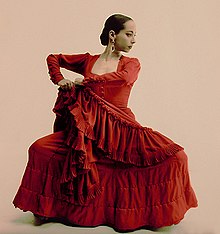This article needs additional citations for verification. (July 2022) |
| Flamenco | |
|---|---|
 Belén Maya, a Flamenco dancer of the gitano ethnicity in traditional dress | |
| Stylistic origins | Andalusi nubah and Romani traditional music |
| Cultural origins | Calé Roma, Andalusian people, Late 18th century, Spain |
| Typical instruments | |
| Derivative forms | |
| Subgenres | |
| Other topics | |
| Flamenco | |
|---|---|
| Country | Spain |
| Domains | Performing arts |
| Reference | 00363 |
| Region | Europe and North America |
| Inscription history | |
| Inscription | 2010 (5th session) |
| List | Representative |
Flamenco (Spanish pronunciation: [flaˈmeŋko]) is an art form based on the various folkloric music traditions of southern Spain, developed within the gitano subculture of the region of Andalusia, and also having historical presence in Extremadura and Murcia.[1][2][3] In a wider sense, the term is used to refer to a variety of both contemporary and traditional musical styles typical of southern Spain. Flamenco is closely associated to the gitanos of the Romani ethnicity who have contributed significantly to its origination and professionalization. However, its style is uniquely Andalusian and flamenco artists have historically included Spaniards of both gitano and non-gitano heritage.[4]
The oldest record of flamenco music dates to 1774 in the book Las Cartas Marruecas (The Moroccan Letters) by José Cadalso.[5] The development of flamenco over the past two centuries is well documented: "the theatre movement of sainetes (one-act plays) and tonadillas, popular song books and song sheets, customs, studies of dances, and toques, perfection, newspapers, graphic documents in paintings and engravings. ... in continuous evolution together with rhythm, the poetic stanzas, and the ambiance."[6]
On 16 November 2010, UNESCO declared flamenco one of the Masterpieces of the Oral and Intangible Heritage of Humanity.[7]
- ^ (Leblon 2003, 72-73)
- ^ (Aoyama 2007, 105)
- ^ (Manuel 1989, 51-52)
- ^ (Hayes 2009, 31-37)
- ^ (Akombo 2016, 240–241)
- ^ (Ríos Ruiz 1997, 16-17)
- ^ "Flamenco". ich.unesco.org. UNESCO Intangible Cultural Heritage List. 2010. Retrieved 30 September 2021.